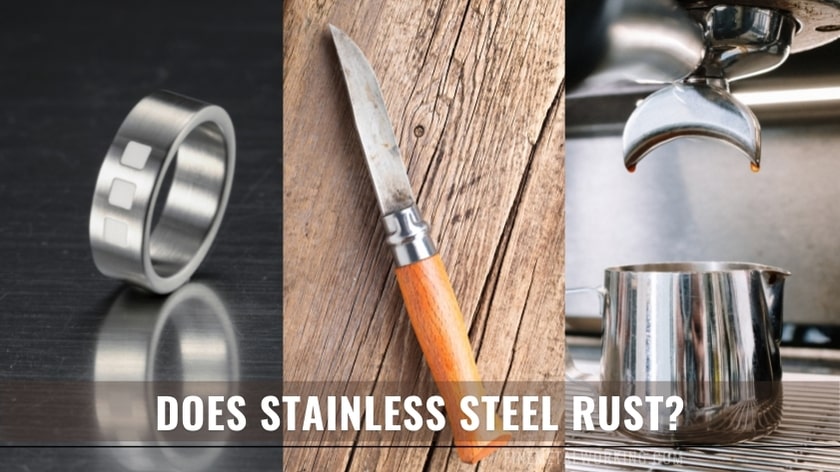Stainless steel is a well-known corrosion-resistant alloy and with good reason. However, there are some cases where it seems that the stainless steel rust. Was it actually stainless steel, or was this part manufactured from an inferior metal? Let’s find out.
Page Contents
Is Stainless Steel Rust Proof?
Stainless steel is highly corrosion-resistant, but it can rust under highly corrosive conditions. Stainless steel kitchenware is unlikely to rust when you use it only for cooking; clean it immediately afterward, and store it away from heat and humidity.
In jewelry, prolonged exposure to sweat and the oils in your skin might cause items to tarnish or rust if they also get nicked and dented. Here, it’s also essential to clean it regularly.
Why Stainless Steel Doesn’t Rust?
Well, it all has to do with the composition of the metal. Stainless steel is an alloy that is made up of iron and carbon with a few other trace elements mixed in. It’s this mixture that keeps stainless steel from rusting, as opposed to unprotected metals like wrought iron or mild steel.
To understand how stainless steel works, let me briefly explain you the composition of this alloy.
What is stainless steel?
Stainless steel is a ferrous alloy of iron with carbon, copper, and chromium as its primary alloying materials. However, nickel and other trace elements could also be added. The chromium content in stainless steel is at least 11% but can be higher.
As the name suggests, stainless steel is resistant to stains in the form of rust and corrosion. This alloy is also completely recyclable and can be recovered entirely from construction sites. This durable metal doesn’t leach components when in contact with water. Thus its composition and physical attributes don’t change in wet environments.
Stainless steel is most often used in environments where high levels of hygiene are imperative, such as culinary and surgical applications.
What keeps stainless steel from rusting?
In short, it’s the high chrome content that keeps stainless steel from rusting. Here’s how that works:
Usually, steel and other ferrous alloys (metals containing iron) rust or corrode when they contact oxygen and moisture. In the case of stainless steel, chromium is more reactive than the other alloying elements. When in contact with oxygen, chromium reacts to form chromium oxide and an inert layer on the item’s surface. This layer acts as a protective barrier, preventing oxygen from reaching the alloy underneath.
When stainless steel gets scratched, nicked, or dented, this protective chromium oxide layer gets damaged, allowing oxygen to reach the layers underneath. Here, the protective chromium oxide layer gets restored again through another round of reactions with oxygen. In this sense, stainless steel is self-healing.
As you can see it is the alloying element that changes the property of the steel including the magnetic property of stainless steel.
To prevent stainless steel from rusting under normal usage conditions, it’s a good idea to clean it regularly. Wiping it down with mild detergent and a clean cloth would suffice. Be sure to dry it properly afterward. Scrubbing stainless steel with steel wool or steel wire could cause rust formation – more in this in the next section.
What grade of stainless steel will not rust?
Surgical-grade stainless steel is the most corrosion-resistant version of this alloy. This is 316 stainless steel, the second most commonly used stainless steel on the market. The most popular form of stainless steel is 304 stainless steel. These two alloys are identical, except that 316 stainless steel contains molybdenum, enhancing its corrosion resistance. This form of stainless steel is suitable for use in marine and chloride-exposed environments, where the risk of corrosion is highest.
What Can Cause Stainless Steel to Rust?
Exposure to highly corrosive environments, such as seawater and other harsh chemicals, can cause stainless steel to rust. There are also cases where stainless steel rusts seemingly in the absence of these environments. Here’s why:
When the local chromium content in stainless steel is high enough to counteract the corrosive environment (i.e., greater than 11%), the stainless steel will not rust. When you scrub down a kitchen sink with steel wool, steel particles break off and remain in the sink. If these aren’t cleaned off and the surface dried thoroughly, the localized raw steel content increases, diluting the chromium content. In effect, in the spots where this wire contacts the sink, you have pockets of non-stainless steel. This exposes the iron in the alloy to oxygen attack, leading to pockets of rust forming.
Rust is a reaction between oxygen and iron, forming iron oxide. Iron oxide is less dense than iron, so it expands and spalls off. Basically, there isn’t enough space for all the iron oxide molecules to remain where they’re formed. When these molecules spall off, they expose a new layer of iron atoms to oxygen, in effect allowing the process to continue until some intervention occurs.
You can enhance the rust-resistant property by powder coating stainless steel that are exposed to harsh conditions.
How to Remove Rust from Stainless Steel?
It’s easy to clean rust off stainless steel and return the item to its pristine, stainless condition.
First, all the rust (iron oxide) should be cleaned off. Here, vigorous scrubbing with a wire brush would suffice. For small areas, you could use a sandpaper to remove the rust.
For larger areas, consider using a power tool like angle grinder with rust removal disc to get rid of stubborn rust.
Next, the area must be thoroughly cleaned to remove all traces of the rust-causing steel particles. A solvent wiped on with a clean cloth is usually the best method to go about this.
Finally keep your stainless steel jewelry, cookware, knifes, tools etc. clean and dry to stop is from rusting again.

